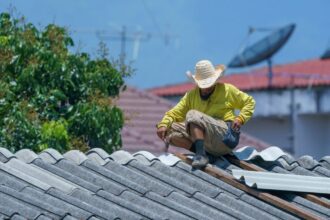Natural disasters can strike with little warning, leaving homes, businesses, and infrastructure severely damaged or even destroyed. The aftermath often includes widespread destruction, emotional stress, and an urgent need for recovery. In these critical moments, storm restoration becomes an essential process—one that involves more than just repairs; it’s about restoring lives, security, and stability, notes Blue Roof Management Specialists.
This article provides a comprehensive look at what storm restoration entails, the various phases involved, how to navigate insurance claims, and what steps homeowners and property managers can take to protect their assets. Whether you’ve experienced storm damage firsthand or want to be prepared for future events, this guide offers valuable insights into one of the most important post-disaster services.
What Is Storm Restoration?
Storm restoration refers to the process of repairing, replacing, and rebuilding structures and systems that have been affected by severe weather conditions. These may include hurricanes, tornadoes, windstorms, hailstorms, blizzards, and other forms of extreme weather. The damage caused by such events can range from minor cosmetic issues to complete structural failures, water infiltration, mold growth, and loss of essential utilities.
Restoration efforts aim not only to return a property to its pre-loss condition but often to improve its resilience against future storms. This process is typically carried out by specialized contractors who understand how to address storm-specific damage efficiently and safely.
Common Types of Storm Damage
Different types of storms lead to different forms of damage. Below are some of the most common issues that require restoration:
Roof Damage
High winds can rip off shingles, tiles, or even entire sections of roofing. Hail can puncture materials, leaving the roof vulnerable to water intrusion. Immediate inspection and temporary tarping are often necessary to prevent further damage.
Flooding and Water Intrusion
Heavy rain, especially when combined with poor drainage or foundation issues, can lead to extensive flooding. Water damage affects drywall, flooring, insulation, and electrical systems. If not addressed promptly, it can lead to mold and mildew, which pose significant health risks.
Wind Damage
Strong winds can topple trees, tear off siding, break windows, and destroy fences or outbuildings. The flying debris generated by windstorms is often a major hazard.
Structural Instability
In severe cases, the integrity of the building may be compromised. This includes cracked foundations, bowed walls, and misaligned doors or windows. Structural engineers may need to be involved in the evaluation.
Utility Disruptions
Storms often knock out electricity, water, gas, or internet. These disruptions can make a property uninhabitable and require urgent intervention.
Phases of the Restoration Process
Storm restoration is not a single event—it’s a sequence of carefully executed phases. Each stage is essential to ensure the safety, functionality, and comfort of the restored property.
1. Emergency Response
The initial hours after a storm are critical. Emergency teams often deploy rapidly to stabilize the situation. This phase may include:
- Boarding up windows and doors
- Applying tarps to damaged roofs
- Shutting off utilities to prevent fire or further damage
- Removing immediate hazards such as fallen trees or exposed electrical lines
The goal is to secure the property and prevent additional damage while a more thorough assessment is conducted.
2. Inspection and Assessment
Restoration professionals conduct a comprehensive inspection of the property. They document every detail of the damage using photographs, measurements, and moisture readings. This documentation is essential for both repair planning and insurance claims.
Depending on the severity of the storm, professionals may use drones or infrared cameras to assess roof damage, detect hidden moisture, or identify structural weaknesses.
3. Debris Removal and Cleaning
Once safety is established and damage is documented, the next step involves removing debris, damaged furniture, ruined building materials, and other waste. Sanitization may also be required, especially if floodwater introduced bacteria or other contaminants.
Specialized cleaning agents and equipment such as industrial vacuums, air scrubbers, and dehumidifiers are used to eliminate mold spores and ensure a safe environment.
4. Repairs and Reconstruction
This is often the longest and most intensive phase. It includes tasks like:
- Roofing replacement or repair
- Replacing drywall, insulation, and flooring
- Fixing broken windows, doors, and siding
- Electrical, plumbing, and HVAC repairs
- Painting and interior finishes
Depending on the extent of the damage, this phase can take anywhere from a few days to several months. In some cases, entire sections of the property may need to be rebuilt from the ground up.
5. Final Inspection and Quality Assurance
Once repairs are complete, a final walkthrough ensures all work meets building codes, insurance requirements, and the property owner’s expectations. Many restoration companies offer warranties or service guarantees to ensure long-term peace of mind.
Insurance and Financial Considerations
Filing an insurance claim is often one of the most stressful aspects of storm recovery. Understanding how the process works can ease frustration and ensure you receive adequate compensation.
How to File a Storm Damage Claim:
- Contact Your Insurer Immediately – Most policies require prompt reporting.
- Document the Damage Thoroughly – Take photos and videos from multiple angles.
- Get a Professional Assessment – Restoration contractors can provide detailed reports to support your claim.
- Review Your Policy – Understand what is and isn’t covered, including deductibles and limits.
- Track All Expenses – Keep receipts for emergency repairs, temporary lodging, and other storm-related costs.
Some storm restoration companies work directly with insurance providers, helping streamline the claim and payment process. This can reduce out-of-pocket costs and minimize delays in getting your home or business back to normal.
Choosing a Reliable Restoration Partner
Not all contractors are created equal, especially when it comes to storm-related damage. The right partner can accelerate recovery, ensure safety, and even increase your property’s value.
What to Look for:
- Licensing and Insurance – Always verify credentials before hiring.
- Storm Damage Expertise – Choose contractors who specialize in storm restoration, not just general construction.
- Insurance Coordination Experience – A good contractor understands how to navigate complex insurance requirements.
- Local References and Reviews – Check customer feedback and ask for project examples.
- Warranties and Post-Repair Support – Make sure the company stands behind its work.
Be wary of fly-by-night operators who show up after a storm offering quick fixes at low prices. These so-called “storm chasers” often leave behind substandard work and vanish before issues arise.
Long-Term Mitigation Strategies
Restoration isn’t only about fixing the damage—it’s also an opportunity to prevent future problems. Smart homeowners and businesses use the recovery phase to invest in mitigation and preparedness.
Mitigation Tactics Include:
- Installing impact-resistant roofing and windows
- Upgrading insulation and drainage systems
- Elevating HVAC systems and critical utilities
- Reinforcing structural components such as trusses and foundation anchors
- Adding surge protectors and backup power systems
These improvements not only offer peace of mind but can also lower insurance premiums and increase property value.
Emotional and Psychological Impact
The toll of a severe storm isn’t just physical—it can be emotional and psychological. Displacement, loss of personal belongings, and prolonged recovery times can be incredibly stressful. Compassionate storm restoration professionals understand this and often offer additional support, such as guidance through the insurance process and flexible payment plans.
Community involvement and neighbor-to-neighbor support can also make a significant difference. Local volunteers, aid organizations, and mental health professionals often become part of the broader recovery effort.
Conclusion
Storms are unpredictable and often devastating, but recovery is possible with the right knowledge and resources. Storm restoration is a vital part of that journey, involving everything from emergency stabilization and detailed assessments to complete reconstruction and long-term prevention.
By understanding the full scope of the process, homeowners and business owners can make informed decisions that speed up recovery, protect their investments, and strengthen their resilience against future storms. From choosing a reliable restoration partner to navigating insurance claims and planning future-proof upgrades, every step matters.
No one wishes for a storm, but knowing how to recover from one is essential—and with the right approach, restoration can lead not just to repair, but to renewal.

















